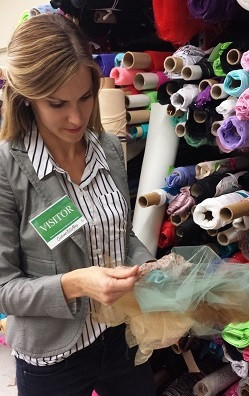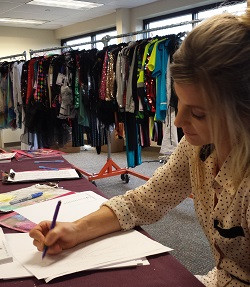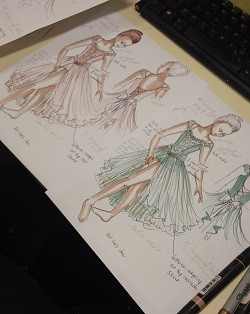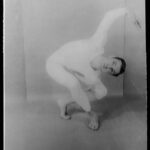Dance costumes hold a unique magic. For dancers, they evoke cherished childhood memories of recitals and represent the embodiment of a choreographer’s artistic vision on stage. As someone deeply involved in the dance world, with a background in both dance and choreography, I’ve always admired the artistry of dance costumes. However, I never considered myself a fashion designer, let alone a Dance Costumer. That was until Linda Bradbury, CEO of Costume Gallery, a leading name in dance costume design, presented me with an exciting challenge: to design a costume for their prestigious 2016 catalog. The invitation to visit Costume Gallery’s headquarters and collaborate with their talented team filled me with a mix of thrill and trepidation. Could I, with my artistic inclinations but limited fashion design experience, create a costume worthy of a professional dance company and appealing to dancers and instructors alike?
 Deborah Searle explores fabrics at Costume Gallery in New Jersey
Deborah Searle explores fabrics at Costume Gallery in New Jersey
Dance Informa’s Editor, Deborah Searle, immersed in a vibrant array of fabric samples at Costume Gallery, NJ, highlighting the crucial role of material selection for a dance costumer.
My fascination with dance costumes began early. Like many dancers, the anticipation of unveiling the year’s recital costumes was a highlight of my childhood dance journey. From whimsical poodle costumes to the retro poodle skirts of Grease, I’ve donned a diverse array of dancewear throughout my performing years. But the prospect of creating a costume, one that balances aesthetic appeal with the practical demands of dance, felt like a leap into uncharted territory. Could I truly contribute to the world of dance costumers?
Arriving at Costume Gallery on a drizzly New Jersey afternoon, I was immediately captivated by a breathtaking panorama of colors and textures. Yards upon yards of fabrics, in every imaginable hue and material, lined the facility. Equally impressive was the passionate and skilled team behind these creations. I had the privilege of collaborating with Design Director Kimberly Keller and Senior Designer Heather Chamberlain. Their patience and enthusiasm were infectious as I, admittedly a bit starstruck, explored their design studio. Being surrounded by rooms overflowing with fabric swatches felt like entering a creative wonderland. I was encouraged to explore and select any materials that sparked my imagination, a crucial step in understanding the work of a dance costumer.
Kim and Heather generously shared insights into their design process, revealing a diverse range of inspirations, from high fashion and bridal trends to the intricate beauty of nature, the emotional depth of music, and unique textiles sourced from global travels. The studio walls served as vibrant mood boards, adorned with inspiring imagery – magazine clippings, sketches, botanical prints, shimmering appliques, and anything possessing a touch of glamour. Heather and Kim guided me through racks of past costumes and design catalogs, tracing the evolution of their creations from initial sketches to finished pieces. For a costume enthusiast like myself, it was an overwhelming and inspiring experience, akin to being a child in a candy store. The sheer volume of exquisite costumes, the abundance of tulle, and the dazzling sparkle of sequins truly defined it as a dance costumer‘s paradise.
Driven by a love for narrative and visual storytelling, I arrived prepared with a collection of ideas, even a Pinterest board brimming with inspirational images. A recent Dance Informa article about Susan Stroman’s Little Dancer musical, inspired by Edgar Degas’ iconic ‘Little Dancer Aged Fourteen’ sculpture, sparked a particular vision. I envisioned a Degas-inspired costume, a design that could bridge the worlds of ballet and contemporary dance. This concept resonated deeply, offering a chance to explore historical inspiration within a modern dance context, a common challenge for a dance costumer.
 Senior Designer Heather Chamberlain at Costume Gallery develops initial costume sketches
Senior Designer Heather Chamberlain at Costume Gallery develops initial costume sketches
Senior Designer Heather Chamberlain expertly crafting the initial sketches, a foundational step in bringing a dance costumer‘s vision to life.
Inspired by video clips of Tiler Peck’s performance in Little Dancer, particularly her costume, and immersed in a book of Degas’ ballet paintings and sketches, I delved into research. I explored online resources featuring Degas’ ballerinas, contemplating how to translate the aesthetic of his 19th-century costumes into a contemporary design. The aim was to create a costume that honored the historical elegance of Degas’ era while incorporating modern versatility, suitable for the evolving landscape of ballet, contemporary dance, and even lyrical jazz – a testament to the adaptability required of a successful dance costumer.
My excitement grew when Kim and Heather embraced my Degas-inspired concept. As I articulated the ideas swirling in my mind, Heather began sketching, capturing the nascent costume design on paper. The costume began to materialize before my eyes! We engaged in a dynamic exchange, refining the design to achieve the desired aesthetic and ensure its appeal to both dancers and instructors. Considerations ranged from flattering lines and movement-enhancing shapes to appropriate coverage and contemporary style – all crucial aspects a dance costumer must consider.
The next crucial stage involved material selection. Which fabrics would best capture the soft, ethereal quality I envisioned? Which materials would complement each other in terms of texture and drape? I gained a newfound appreciation for the intricate decision-making inherent in every Costume Gallery design. With approximately 400 diverse costumes in their annual collection, the depth of planning and expertise became truly apparent. The meticulous work of a dance costumer was unfolding before me.
My vision leaned towards a romantic, vintage-inspired aesthetic, drawing directly from the color palettes found in Degas’ renowned paintings. The challenge lay in selecting hues that evoked an aged charm yet retained sufficient vibrancy to command attention on stage. We opted for a dusty gold tulle, subtly sprinkled with glitter, to form the base of the layered skirt. This was then overlaid with tulle in blush pink or teal, offering two distinct color variations. For the bodice, we chose either blush pink or teal lycra, accented with exquisitely delicate, lightly-sequined lace panels at the center front. The sleeve design and the low-scooped back, complete with a sash and bow, echoed the silhouettes of Degas’ late 19th-century dancers. However, the skirt’s cut and modern flair offered a contemporary, edgier interpretation of the traditional romantic tutu – a fusion of classic and modern elements that a skilled dance costumer strives to achieve.
 The final costume design and color options created at Costume Gallery
The final costume design and color options created at Costume Gallery
The finalized costume design and color variations, demonstrating the collaborative process between a guest designer and experienced dance costumers at Costume Gallery.
Through sketching and experimenting with a multitude of fabric swatches, the final design, color scheme, and materials were meticulously chosen. To my delight, I had indeed designed a costume! And, I must admit, a rather beautiful one! While I felt a surge of accomplishment, I remained acutely aware that the true magic stemmed from Kim and Heather’s extensive experience and discerning design sensibilities. Their expertise and passion are the driving force behind Costume Gallery’s exceptional creations. They are truly gifted dance costumers.
What awaited my Degas-inspired design? The next phase involved the pattern maker, tasked with creating the precise sewing pattern. Materials were ordered, and a prototype, or mockup, would be constructed for my review. This stage would reveal the costume’s real-life appearance and assess its feasibility for stage performance. Practical considerations, such as production costs based on sewing complexity and material expenses, would be evaluated. Design adjustments might be necessary before final approval. Ultimately, the costume would be expertly sewn and brought to life by a young dancer in early 2015 for the Costume Gallery catalog photoshoot. I eagerly anticipated witnessing my design’s transformation from concept to tangible creation, a journey that highlights the multifaceted role of a dance costumer in bringing artistry to the stage.
Follow Dance Informa on Instagram @DanceInforma and Facebook/danceinforma for updates on the costume’s progress!
Photo (top): Initial costume design sketches, capturing the nascent ideas of a collaborative dance costumer project.

